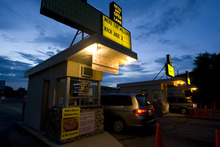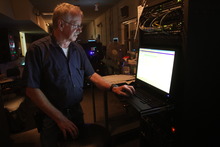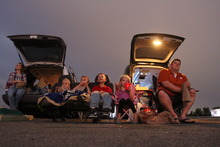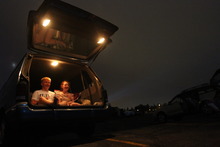This is an archived article that was published on sltrib.com in 2013, and information in the article may be outdated. It is provided only for personal research purposes and may not be reprinted.
West Valley City • As kids, Travis Cornaby and his siblings piled into the family Ford with homemade popcorn and fistfuls of candy, then headed to the Redwood Drive-in to catch the "The Pink Panther," "Young Frankenstein" and "Caveman."
They usually crashed by the end of the first feature.
On a recent August evening, Cornaby pulled up to the open-air theater with Aimee, his wife, and their two children, Gracie, 12, and Brenyn, 14.
An FM radio station replaced the speaker boxes he remembered from childhood. And four screens glowed instead of just one.
"Besides that, I think it's exactly the same," said the 43-year-old father. "It's great to see that it's still around after all these years."
—
Digital conversion • Families, sweethearts and others liken the drive-in to an old pal who hasn't changed much in the past few decades. But nationwide, the outdoor venues are undergoing some pricey, nonelective surgery: switching from film to digital.
Studios and other entities along the distribution line are phasing out the old film reels, replacing them with blocky, metallic hard drives.
Drive-in owners have no choice but to shut down the old film projectors, some with midcentury parts, and buy new digital versions, which cost about $70,000 each. Some drive-ins, including several in Utah, have been unable to shoulder the hefty price and have dimmed the lights for good.
"It's a big hit," said Brent Coleman, owner of the still-going Riverdale Motor Vu drive-in, near Ogden.
Coleman is one of many owners across the nation who found that hosting weekend swap meets helps cover the cost. It's something that has helped the Redwood Drive-in afford the conversion to digital as well.
But for dozens of smaller, family-run drive-ins with only a screen or two, it now makes more sense to sell the land and get out of the game.
—
Comeback kid • In the 1950s, about 4,000 drive-ins operated nationwide, drawing audiences by the acre and bringing in the bulk of studio revenues. But most have closed as cities expanded and moviegoers turned to walk-in theaters. There are now fewer than 400 drive-ins in the U.S.
The switch to digital could fortify drive-ins by allowing the outdoor theaters to broadcast concerts and other shows or events, such as the Super Bowl, said D. Edward Vogel, spokesman for the United Drive-in Theaters Association and operator of a Maryland drive-in.
"The sky's the limit," Vogel said, noting that he didn't know too many indoor theaters "that would want people drinking indoors and yelling and screaming and throwing trash at the screen."
It wouldn't be the first drive-in revival, said Frank Huttinger, a Southern California drive-in operator and owner of the Redwood. In the 1990s, a slew of animated Disney flicks, such as "The Lion King," helped draw families back to the open-air showings.
This summer, the National Association of Theater Owners and some movie studios are helping some drive-ins cover the cost of the digital switch.
Others are pledging to help, too. Carmaker Honda, for example, is promising to pay for five theater conversions under a recently announced program.
But the outdoor venues face other hurdles, like diminished crowds and light from nearby convenience stores, shopping malls and roadways. In addition to the new projectors, other costs have risen in recent years.
—
In the booth • Redwood projectionist Earl Shafer hauled reels and manned projectors for 40 years. That ended this summer when the Redwood switched to digital. Shafer now runs the drive-in's four digital screens — down from six — with a few commands on a keyboard and 165-megabyte hard drives.
The switch makes for a brighter picture with fewer flickers, he says, but it sometimes looks fake and metallic. Film has a richer depth you can see in the old shows such as "Oklahoma!" and "Star Wars," he said.
Pennsylvania, Ohio and New York now count the highest concentration of the open-air theaters. Texas and California are also rank among the top.
As of March, Utah had six theaters, according to Vogel's organization.
These open-air venues charge only a few bucks, so they'll stick around, fans contend. The perks: If you don't like the movie, watch the stars or the crowd. Go ahead and bring your own pizza, but the snack bar doesn't cost much, either.
One trend has stuck through the decades, Shafer said. "During intermission, Mom and Pop come into the snack bar holding hands, no matter what age they are," from high-school couples to others approaching their 90s.
—
Summer nights • Amelia Tupouniua and Hailey Hardy, seniors at Kearns High School, came recently for their first drive-in showing. They took to Twitter earlier in the evening, sending an open invite to join them for "The Smurfs 2." Some members of their drill team showed up.
"I think it'd be fun with our whole team," Hardy said.
Travis Cornaby's daughter Gracie, 12, goes to multiplexes, she said, munching on crinkle-cut fries. But "I love it out here more. You can feel the air and the breeze." The redhead previously saw "Toy Story 3" and "Brave" at the Redwood.
Such family evenings create a positive buzz in the drive-in lots, said Ken Adam, a director at large for the UTDA.
"You see a kid here when they're a baby," he said. "And the next thing you know, they're driving here."
Salt Lake City: An iconic backdrop
In 1958, Life Magazine photographer J.R. Eyerman captured the feel of the midcentury drive-in with a photograph he took in Salt Lake City. It shows a congregation of cars pulled up to a towering screen with Charlton Heston playing Moses in "The Ten Commandments."
For the shoot, Everman lured dozens of local college students to the showing of the 1956 film " … And God Created Woman" featuring Brigitte Bardot, said his daughter Kathryn Marshall. He chose Utah because he wanted a rural drive-in surrounded by mountains, she said.
For the photo that was actually published, Everman swapped Heston's image for Bardot's.
The iconic picture "engages us. We smile a little bit, and we're touched by it," Marshall said. Plus: "The idea that he'd come up and run Brigitte Bardot for the Mormons was pretty funny."











